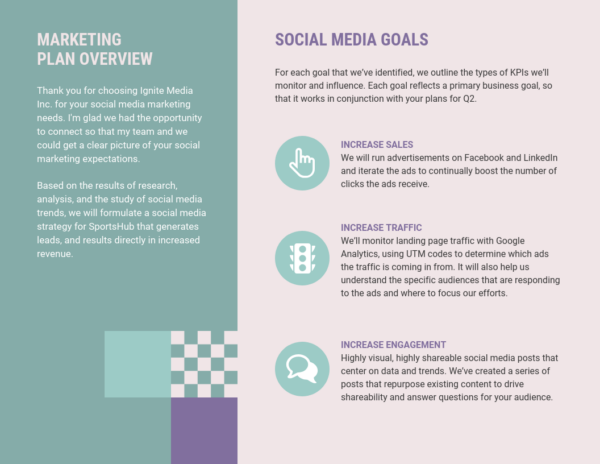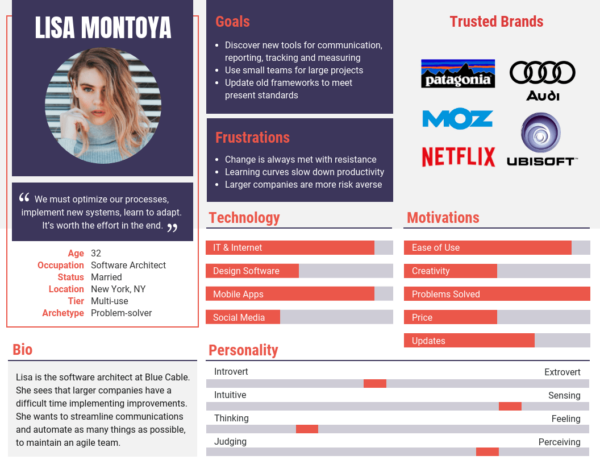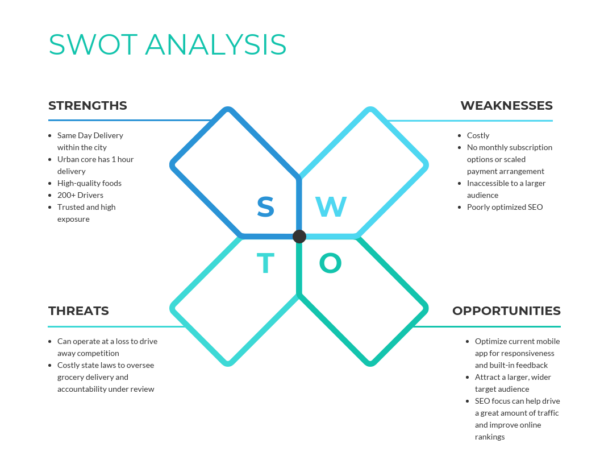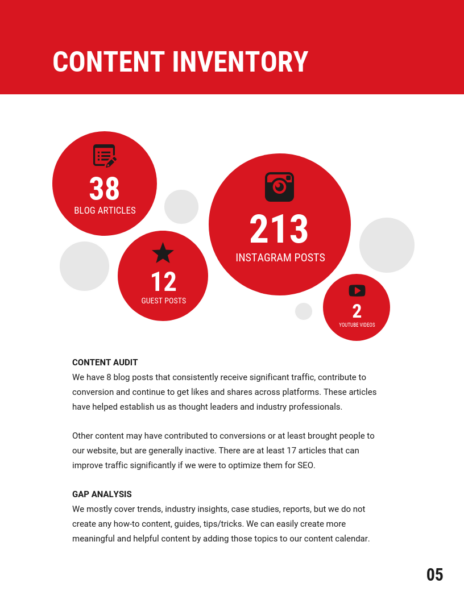Almost 4 months into 2020, and the world has changed in ways we never imagined—which means marketing teams are scrambling to adjust their marketing plan for the rest of the year.
The question is: do you stick with the tried and tested format you have always used to plan your strategy, or do you opt for a new process considering the change in customer lifecycles?
If you are still on the fence about how to adjust your plan, we have the answers for you. Below, we outline how you can create a new plan, plus a few examples to help you along the way.
Marketing Goals
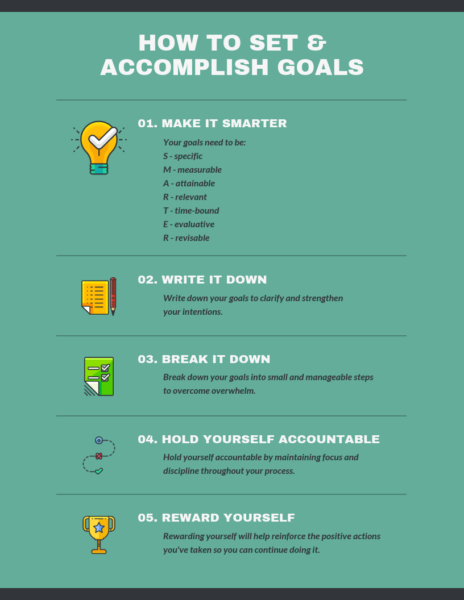
- Source: Venngage
Every great marketing plan starts with outlining the goals for the business. You need to know why you are adjusting your plan, and understanding your goals will help with that.
It is important to understand current marketing trends—which have changed significantly because of recent events—and define how your business can follow them.
Once you know which trends your marketing team is equipped to follow, you can begin outlining your goals.
Remember that the goals you choose for your marketing team need to be measurable and attainable—the world has changed, and so should your goals.
Wanting to earn a million dollars in ad revenue in the coming year is wishful thinking, not practical.
The goals you set should also be specific. If your goals are vague—such as increasing Instagram followers, or more traffic to your website—the team will find it hard to action them.
Instead, your metrics should be specific—200 new followers on Instagram per month, or 10% more traffic to product pages every quarter.
Specificity can be measured and is also easier to aim for—you can track the number of followers and the percentage increase in traffic to see how well your plans are working.
But, it is important not to get too specific in your marketing plan—don’t ask your team to grow followers by 10 per day, or outline the exact methods to be used for increasing traffic.
Some flexibility needs to be built into the plan—digital marketing is an arena that is constantly evolving and if your plan is too rigid, you will not be able to adapt to changes.
Plus, the marketing team is made up of individuals with their own sets of skills—they need a little guidance but they don’t need to be told how to do their jobs.
Choose reasonable, measurable metrics for your marketing plan and you will be better placed to tackle the new 2020.
Plan Summary
- Source: Venngage
With your goals decided, your marketing plan should include a concise but precise summary of what the plan for 2020 is.
Brevity is important here—a summary, by dint of its name, should be short. This is not the place to outline everything in your plan—the rest of the document works for that.
The summary is meant to give context to the document—why are you here, how did you get here, and where does the company want to go from here.
Two to three short paragraphs summarizing the above is all you need in this section of your marketing plan.
Target Audience
- Source: Venngage
Every business has a target group of people who their products and services will most appeal to—your marketing plan needs to understand their current needs.
Understanding your target audience is the key to creating a better customer experience, according to GetVoIP—if you know exactly who your marketing content is for, you will be able to tailor it for them.
While you should mention your target audience in the marketing plan, you should also be adding significant details about your user personas.
Every marketing plan should include at least 2-3 user personas—these will represent the most likely customers your content will appeal to.
Your personas will detail demographics like age and location, but should also look at other key areas such as profession, current living conditions, and financial status.
But your user persona really needs to delve into the psyche of your target audience—what do they need now, how are they using the internet, what are their frustrations, what solutions do they want?
You need to ask these questions and gather the answers—through quizzes, surveys, focus groups, and social media polls—to determine their psychographic segmentation.
The user personas you create will drive your content marketing plan and channels, so spend a good amount of time building it before implementing your new 2020 marketing plan.
SWOT Analysis
- Source: Venngage
An essential building block of your marketing plan is based on understanding how your marketing strategies have worked in past years.
To do this, conduct a SWOT analysis—strengths, weaknesses, opportunities, and threats—on the previous year’s marketing plan.
You can use a SWOT analysis template to create this section of your marketing plan. But you will need to be ruthless and objective in your analysis.
Study the numbers you’ve achieved, the best responses you have seen for your content, and analyze the marketing efforts that worked and didn’t work.
Also consider conducting a SWOT analysis on your competitors. Competitor research is an excellent way to understand where you are falling behind, or are ahead in the industry.
This is the kind of research that can also shed light on gaps in the market that you could potentially exploit.
A SWOT analysis is an important exercise when creating a marketing plan—it reveals the flaws of previous strategies and can shine a light on new areas that can be utilized for success.
Content Plan
- Source: Venngage
A content plan isn’t always a necessary part of a marketing plan, but with there being such uncertainty ahead of us right now, it can’t hurt to include one.
A few things to include in your content plan are the channels for content distribution—are you going to be using the same ones as before, or will you be trying something new?
Remember, people are home now and looking for ways to distract themselves—hosting podcasts or creating videos on TikTok may be more fruitful in the long run.
Your content plan should be more of a broad overview—you will have an idea of what launches and events are being moved around, so tailor your plan according to those milestones.
However, this is not the place to go into the nitty-gritties of your content—you can say that you will be writing four blog posts a month or collaborating with influencers, but no more than that.
It’s important to be flexible with your content plan—the need for content will change over the course of the year, and if you are hemmed in by a rigid plan, you could miss opportunities.
Create a content plan guideline for your marketing plan document but leave room for it to be adjusted during the year.
Promotion Strategy
The content plan you create will outline the kind of content your marketing team will focus their efforts on for the rest of 2020, but content creation is only one part of content marketing.
You also need to determine how you will be promoting the content you create—writing blogs or hosting podcasts on your company’s site is fine, but how will people actually see that content?
You can post the blogs or podcast links on social media, share them in your email marketing campaigns, repurpose them as infographics, or try affiliate marketing. David Campbell, Marketing Strategist at Right Inbox, believes it’s crucial to include influencers in your content. Utilize the influencers sharing power with their social media audiences when promoting your content.
To increase traffic to certain product pages or for a specific period of time, you can hold a giveaway promotion or social media contests.
You can also determine which content can be used for Instagram ads, and how to optimize your content for SEO.
Including your promotion strategy in your marketing plan is a good way to decide which channels are worth spending time and money—which are in short supply—in 2020.
Measuring Success
As we have mentioned before, your marketing plan can only be a success if you measure the outcome of your efforts.
It cycles back to the goals that we set up in the very first point of this exercise—those metrics will help you understand what part of your campaign is working, and what isn’t.
You can use marketing automation tools to examine data from past months and years, so you have a good idea of what changes you need to make.
Measuring and analyzing is an ongoing process and though it can seem time-consuming, the answers it gives you are far more important than the work involved.
Conclusion
The above steps show you how to adjust your marketing plan to the new circumstances of 2020.
Remember to always keep room for flexibility—there is so much we still don’t know—and to measure your upcoming campaigns so you know where your successes and failures lie.
A marketing plan is a stepping stone towards marketing success—put the effort into your plan right now, and you will be better equipped to handle the rest of the year.
